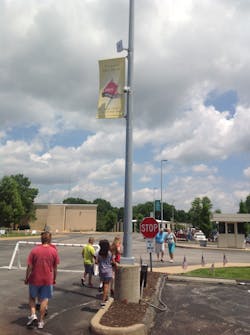The network physical connection of every security system is often overlooked, and many times, is taken for granted – after all, it is the cameras, access control, and intrusion devices that are the key elements to any successful system, isn’t it? With all this information passing from device to head-end, how does it get there every second of every day?
When a security network is confined to a comfortable building with stable heating and cooling, protection from moisture and rough treatment, it is much easier to choose the equipment that keeps all that data moving; however, securing an outdoor area involves many parameters that need to be accommodated, such as temperature extremes, rain, snow, moisture, shock, vibration and long distances. Add in the possibility of lightning and electrical surges, and the challenge of designing a network to operate in harsh environments becomes clearer.
Harsh, industrial applications require environmentally hardened products, as the network and the information delivery system have to be up to the task of working at all times, in any condition. Some of these rugged industrial applications include: industrial warehouses and factories; intelligent transportation systems for roads and bridges; critical infrastructure, city surveillance, parking facilities, airports, train stations, stadiums, schools and university campuses.
Product Checklist
Here are six considerations to help integrators and end-users choose the right transmission equipment to operate in harsh environments:
1. NEMA TS-1, TS-2. NEMA stands for the National Electrical Manufacturers Association, which gives products ratings that define the types of environments where an electrical device can be used. Be sure the product conforms to the TS-1 and/or TS-2 standards.
2. Extended operating range. -40º C to + 75ºC is the preferred temperature operating range for IP products. Look for products that do not need internal cooling fans or moving parts to operate – they are potential points of failure within a switch or network device. If the fan fails, the switch will fail.
3. 5% to 95% non-condensing humidity. Choose products that can operate in humid conditions – this does not mean they can operate under water, but be assured they can work in moist environments and continue to work without the worry of corrosion. For harsher humidity such as Florida, choose a supplier that can conformally coat any device for further protection.
4. Consider shock and vibration. Roadside cabinets, industrial manufacturing facilities, light poles, rail stations and trackside are just some of the locations where network hardware will be subject to extreme vibrations and shock. Be sure to choose products that can handle those extremes.
5. Transient voltage or unexpected electrical charges. Use products that are developed for random electrical occurrences.
6. Warranty. A good warranty offers peace of mind knowing if something does go wrong, the company whose name is on the product will fix or replace it should something fail.
Enclosures
As resistant to the extremes brought on by harsh environments are for these hardened products, they still require an enclosure to protect them. If you try to use standard commercial-grade hardware in applications for a rugged application, the protective enclosure would require heating and cooling and a larger enclosure to protect the network hardware within it.
Industrially hardened equipmentcan be installed in a smaller enclosure that should be NEMA 4 or 4X rated and requires no heating or cooling. Power requirements without heating and cooling are much lower, as is the cost of ownership over time. An integrator can also put other smaller form-factor network gear – such as media converters, switches and power supplies – to supply power to PoE-powered connected devices, such as IP cameras and access control panels.
Solving Distance Challenges
Most harsh environment applications – highways, railways, campuses, city centers, large factories and others –are larger than a standard building and have distance challenges greater than the accepted 100 meters achievable over a standard Cat6 UTP cable. Here are three ways to overcome those distance challenges for your IP network.
1. Extended distance Ethernet over UTP or coax. There are hardened products that can extend 100Mbps transmission throughput distance over 600 meters. They are designed to operate in tough environments and are immune to most extremes. If an application calls for PoE security devices, these devices can extend the transmission distance while providing operating power to a camera or other device.
2. Fiber Optic Ethernet. Fiber optic Ethernet transmission still has no equal in terms of bandwidth over distance. Combine that capability with the rugged design and hardened product, fiber optic offers advantages other media cannot. For IP devices located at the edge or most remote part of the installation, a hardened media converter or switch makes good design sense. In installations such as a parking garage where multiple cameras are required, using a fiber optic media converter for distance, brought back to a hardened switch with a gigabit, 2.5 or even 10Gbps uplink port to the head-end works well. The switch and media converters can survive in the harsh environment of a parking garage with the temperature extremes and vibration encountered. PoE devices can be accommodated by a PoE Ethernet Switch or edge media converter.
3. Wireless Ethernet. There are many industrial applications where the availability to install fiber optic or copper cable becomes cost-prohibitive or even impossible. Imagine the costs for trenching and conduit alone when installing new cabling in a city center, rail yard or port. In these types of industrial applications, wireless Ethernet becomes a viable transmission medium.
Wireless Ethernet can be used in a number of different manners. It can be used as a simple point-to-point link, for example, a remote camera to a light pole in a parking lot. It can be used as a point-to-multipoint installation with multiple cameras on multiple light poles coming back to a head-end monitoring location.
When choosing wireless equipment, confirm the products meet current IP (Ingress Protection) ratings for hardened products. IP67 is considered the standard for wireless products, and it means internal components are protected by "dust tight" enclosures that are protected against immersion.
Powering Equipment in Harsh Environments
If an application requires security equipment to operate in difficult, unconditioned, out-of-plant environments, be sure to consider how the devices are powered. If the installation has AC operating power, it becomes a little easier. In most instances, with an incoming 120VAC supply of electricity, an AC to DC power supply is used to power the devices.
Cameras and network gear can vary in power requirements. Some operate on 24VAC, others 12-48VDC. PoE devices require 48VDC at different amperages to supply ranges of Wattage to power these devices.
Most equipment manufacturers offer models that are PoE powered. From cameras to access control to anything that is IP based, it is far easier to install and for the most part, eliminates the need for local power where these edge devices are located.
As IP powered devices (PD) are developed, network transmission product manufacturers are constantly developing products to supply that power. The challenge now is the ever-increasing requirement for more delivered power. The first standard, IEE 802.3af is for 15 watts, IEEE802.3at or PoE+ was for 30 watts and now IEEE802.3bt 4PPoE or UPOE is for 60 watts. As these PDs require more power for the use of PTZ, and blowers and heaters, more power must be supplied.
When installed in extreme temperature locations, be sure to de-rate a power supply – for example, at 75˚C a 240W supply is only supplying about 120W, so if you need 240W on a PoE switch that supplies power to cameras, the requirement to meet the real power needs would be to select at least a power supply that delivers 480W.
In many locations where surveillance and security are a necessity, having operational power onsite often is not; in fact, for many remote locations, onsite power can be unreliable, only available for a limited number of hours per day, or completely unavailable.
In these locations, solar energy solutions are available. A typical kit consists of solar panels, batteries, a power controller or injector, and a NEMA enclosure. The kit can be configured depending on the hours of available daylight and the amount of output power required.
A solar kit can generate and store enough power to run cameras, power the network equipment as well as a wireless link back to the network – making it possible to have surveillance and security equipment in the most remote locations.
In applications where the availability of power may be inconsistent with frequent outages, battery backup solutions can provide power. These solutions contain batteries, DC power controller/charger, transformer and NEMA IP-65 weathertight enclosure.
In applications where the power is switched on and off from a central location – for example, a light pole at a remote location in a parking lot, the battery backup can power the security and surveillance equipment during the day and recharge overnight when power to the light is on.
Moses Ramos is Senior Trainer, Guy Walker is North American Training Manager, and Frank “Skip” Haight is VP of Marketing for ComNet. Request more info about the company at www.securityinfowatch.com/10215705.



